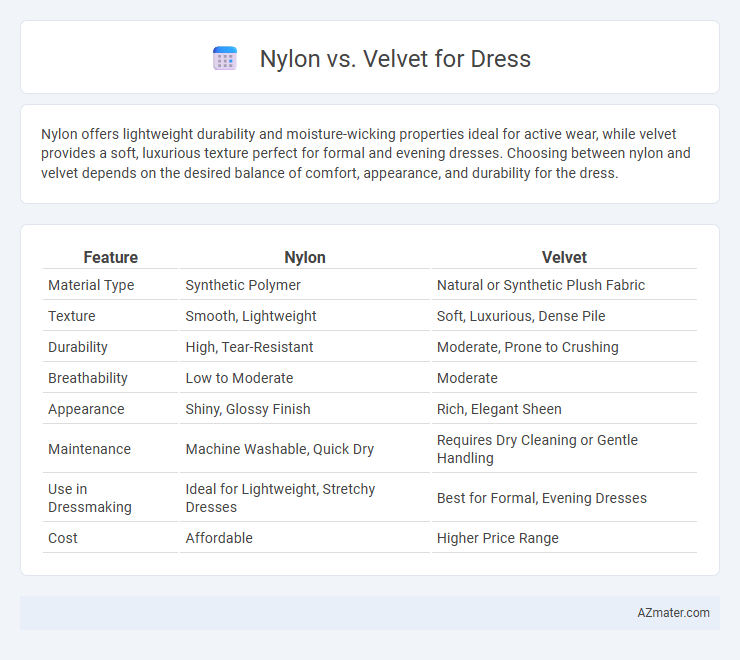Nylon offers lightweight durability and moisture-wicking properties ideal for active wear, while velvet provides a soft, luxurious texture perfect for formal and evening dresses. Choosing between nylon and velvet depends on the desired balance of comfort, appearance, and durability for the dress.
Table of Comparison
| Feature | Nylon | Velvet |
|---|---|---|
| Material Type | Synthetic Polymer | Natural or Synthetic Plush Fabric |
| Texture | Smooth, Lightweight | Soft, Luxurious, Dense Pile |
| Durability | High, Tear-Resistant | Moderate, Prone to Crushing |
| Breathability | Low to Moderate | Moderate |
| Appearance | Shiny, Glossy Finish | Rich, Elegant Sheen |
| Maintenance | Machine Washable, Quick Dry | Requires Dry Cleaning or Gentle Handling |
| Use in Dressmaking | Ideal for Lightweight, Stretchy Dresses | Best for Formal, Evening Dresses |
| Cost | Affordable | Higher Price Range |
Introduction to Nylon and Velvet Fabrics
Nylon is a synthetic fabric known for its strength, elasticity, and resistance to abrasion, making it a popular choice for durable and lightweight dresses. Velvet, a woven fabric characterized by its soft, dense pile, offers a luxurious texture and rich appearance ideal for elegant and formal attire. Comparing nylon's practicality with velvet's opulence helps determine the best fabric choice based on dress design and occasion.
Key Characteristics of Nylon
Nylon fabric is lightweight, durable, and highly resistant to abrasion, making it ideal for dresses that require long-lasting wear and easy maintenance. Its smooth texture and excellent elasticity provide a comfortable fit while maintaining shape over time. Nylon's quick-drying and moisture-wicking properties create breathable and practical garments, especially compared to the plush and heavier texture of velvet.
Defining Features of Velvet
Velvet is characterized by its dense pile of evenly cut fibers that create a soft, plush texture with a natural sheen, distinguishing it from the smooth, synthetic finish of nylon. The fabric's luxurious appearance and tactile warmth make it ideal for elegant dresses, offering depth and richness that nylon's lightweight, durable qualities lack. Velvet's composition, often cotton, silk, or synthetic blends, contributes to its heavier weight and fluid drape, providing a distinctive silhouette and comfort in formal wear.
Comfort and Wearability Comparison
Nylon offers lightweight breathability and moisture-wicking properties, making it comfortable for extended wear and active occasions. Velvet provides a plush, soft texture with a heavier weight, ideal for cooler weather and formal events but may retain heat and limit airflow. Choosing between nylon and velvet for dresses depends on desired comfort level, climate, and wearability needs.
Durability and Longevity: Nylon vs Velvet
Nylon outperforms velvet in durability due to its synthetic fibers that resist abrasion, stretching, and tearing, making it ideal for long-lasting dress materials. Velvet, typically made from cotton, silk, or synthetic blends, offers a luxurious texture but is more prone to wear, pilling, and crushing over time. Dresses made from nylon maintain their shape and appearance longer, while velvet requires careful handling to preserve its softness and visual appeal.
Style and Aesthetic Appeal
Nylon dresses offer a sleek, modern look with a smooth texture and slight sheen that enhances contemporary style, making them ideal for active or casual wear. Velvet dresses exude luxury and sophistication with their rich, plush texture and deep, vibrant colors, perfect for formal events and evening occasions. Choosing between nylon and velvet depends on the desired aesthetic--nylon for a lightweight, polished finish and velvet for an opulent, dramatic effect.
Care and Maintenance Requirements
Nylon dresses require minimal care, often machine washable and quick-drying, but should be kept away from high heat to prevent melting or damage. Velvet dresses demand more delicate handling, including dry cleaning or gentle hand washing, with careful drying to maintain texture and avoid crushing the pile. Proper storage for velvet involves hanging in a breathable garment bag to preserve fabric softness and avoid unwanted creases or marks.
Suitability for Occasions and Seasons
Nylon dresses offer excellent durability and moisture-wicking properties, making them ideal for active events and warmer seasons due to their lightweight and breathable nature. Velvet dresses provide a luxurious texture with excellent insulation, perfect for formal occasions and cooler weather, especially in fall and winter. Choosing between nylon and velvet depends on the event's formality and seasonal comfort requirements, with nylon suited for casual or outdoor summer events, and velvet preferred for elegant evening wear in colder months.
Price Comparison and Value
Nylon dresses generally offer a lower price point compared to velvet due to the synthetic fiber's cost-effective production and durability. Velvet, often made from cotton, silk, or polyester blends, commands a higher price because of its luxurious texture and richer appearance, making it a premium fabric choice for formal wear. When considering value, nylon provides practical affordability and easy maintenance, while velvet offers a superior aesthetic and tactile experience that can justify its higher cost for special occasions.
Choosing the Right Fabric for Your Dress
Nylon offers durability and stretch, making it ideal for form-fitting dresses that require flexibility and moisture resistance. Velvet, with its luxurious texture and rich appearance, suits formal or evening dresses where elegance and a soft touch are priorities. Choosing the right fabric depends on the occasion, desired comfort, and dress silhouette, as nylon supports active wearability while velvet emphasizes opulence and warmth.

Infographic: Nylon vs Velvet for Dress
 azmater.com
azmater.com